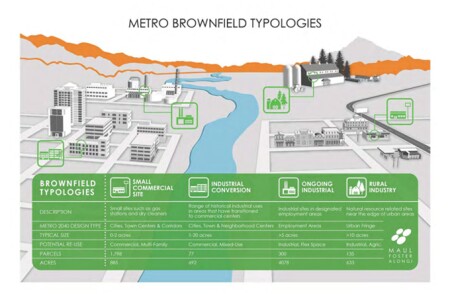Public resources for the private sector make this program notable.
In January 2023, Oregon debuted its $5 million Brownfields Properties Revitalization Fund (BPRF), which offers forgivable loans to private owners and operators to support remediation at sites that are contaminated or perceived to be contaminated. For eligible projects, the BPRF can reimburse up to half of remediation costs or $250,000, whichever is less, and it can provide up to $500,000 for projects that include certain enhancements. Examples include publicly available electric vehicle–charging infrastructure, affordable housing, development in a rural or distressed area, or remediating a brownfield that was contaminated due to wildfire.
Oregon’s Business Development Department (d.b.a. Business Oregon) has had the ability to extend low-interest loans to private entities through its Brownfields Financing Program since 2000, but having the flexibility to forgive loans is new and significant. Jessy Ledesma is founder and principal at Portland-based HomeWork Development. A member of both ULI and WLI Portland, she is part of an application to the BPRF, which represents a critical new resource for her projects.
“[The BPRF] provides a unique opportunity to utilize brownfields sites for affordable housing development, which are often sites that would otherwise be too difficult or costly to do so,” says Ledesma. Turning former brownfields into affordable housing is what Ledesma calls “an ‘all hands on deck’ challenge,” requiring intentional partnerships—like the BPRF—between state agencies, local governments, and developers. “Often urban infill properties have brownfields conditions that are not insurmountable for redevelopment,” she says. “With a creative tool like BPRF we can turn these under-utilized properties into something our community badly needs.”
The BPRF is a direct result of six years of lobbying efforts by the Oregon Brownfield Coalition and its more than 50 public, private and nonprofit sector members, which range from private engineering and law firms to non-profit advocacy groups, and include agency partners that participate in discussions but don’t lobby, like the Oregon Department of Environmental Quality (DEQ) and the US Environmental Protection Agency (EPA). Forgivable loans are grants by another name, and the BPRF is one of few such programs that target private actors. That alone makes it noteworthy, but the story of its development and the larger history of the Oregon Brownfield Coalition is instructive for anyone with a stake in land reuse, infill, and sustainability.
Building a better brownfield redevelopment process
“We’re always trying to figure out how to address the challenges here in Oregon that hold back redevelopment on properties,” says Karen Homolac, Brownfields Program Specialist at Business Oregon, the state’s economic development agency. Homolac manages the Brownfields Financing Program, which houses the BPRF along with two other revolving loan funds designed to spark assessment, remediation, and reinvestment.
Oregon’s land use regulations, which since the 1970s have used urban growth boundaries to protect agricultural and forest land, make infill development and brownfield revitalization particularly important for cities and builders alike. In the mid-1990s, as EPA was establishing its Brownfields Program, Oregon shifted its approach to contaminated sites from a regulation-driven to a risk-based approach, seeking to harness the power of public and private sector investment to bring derelict properties back online. Oregon was one of the first states to establish a fund to support brownfield assessment and cleanup. It housed grant and loan mechanisms within Business Oregon, and regulatory functions with the DEQ.
Business Oregon’s funding programs took off. The public sector-serving cousin of the BPRF, the closely named Brownfields Redevelopment Fund (BRF), was initially capitalized with $500,000 in 2001. It is currently capitalized at $26.5 million, with revenues of $14.6 million. To date, the BRF has provided over $10 million in grant funding and $20 million in loan financing to 245 projects statewide. Separately, Business Oregon manages a Brownfields Cleanup Fund capitalized by a USEPA Brownfields Revolving Loan Fund Grant. From an initial $1.5 million seed grant, it has provided more than $6.9 million in grant funding and loan financing to an additional 23 redevelopment projects.
At 20 years old and with a substantial number of mature brownfields redevelopment projects behind it, Business Oregon is soon to embark on a return-on-investment analysis of the BRF, which will update a 2014 Economic Impact Analysis of state brownfields support. That study examined 51 redevelopment projects and demonstrated that every $1 of state investment leveraged $116 of additional funding, resulting in $2.3 billion in economic activity, 8,900 new on-site and indirect jobs, and $19 million in tax revenue to the state.
The BRF offers an important source of catalytic funding to local governments, non-profits, and private property owners seeking to jump-start redevelopment of a problem property. In states that offer no financial support for brownfield redevelopment, cities depend on oversubscribed federal grants. While larger than the typical Business Oregon award, the highly competitive nature of EPA’s annual federal brownfields grant competition puts the lowest capacity and highest need communities at a disadvantage. State funds like Business Oregon’s create opportunities for local governments of all shapes and sizes to redevelop contaminated land, from planning to redevelopment.
For the private sector, however, state funding was historically limited to low-interest loans, and that created significant constraints for builders like affordable housing providers – bad news in a state in which half of all renters and a quarter of all homeowners are estimated to be housing burdened (paying more than 30 percent of income for rent and utilities). Brownfield funding can’t solve the world’s problems, but it can help. Despite a robust state program, a group of Oregon advocates saw opportunities for improvement.
Oregon’s Brownfield Coalition goes to bat
Even as far back as Oregon’s recovery from the 2008 recession, “the need for additional brownfield redevelopment resources was clear,” recalls Randy Tucker, retired Legislative Affairs Manager for Metro, the Portland area’s regional government. In 2012, Metro’s Regional Brownfield Scoping Project estimated that the area of contaminated sites across the Portland metropolitan region could be as high as 6,000 acres—an estimated 7 percent of all commercial, mixed use, and industrial space within the region’s urban growth boundary.
Contaminated sites were three times more likely to be located near underserved communities, and over 50 percent of contaminated sites were close to environmentally sensitive areas. Metro estimated that these sites, if redeveloped, could generate $324 to $427 million per year in new property tax revenue, support 138,000 new housing units, and create space for 69,000 new jobs.
Unfortunately, the majority were small, like gas stations and dry cleaners. More than the cost of remediation, their redeveloped value was constrained by market factors like rental rates. Private redevelopment of these properties would require tax incentives, dedicated funding resources, and a streamlined regulatory framework.
Compounding the issue, bills to support brownfield redevelopment kept failing to make it out of the state legislature. While the issue enjoys bipartisan support at all levels of government, this can counterintuitively make it challenging to secure resources and attention.
The Oregon Brownfield Coalition emerged in 2014, and through the 2021 legislative session, it enjoyed significant policy and funding wins in support of brownfield redevelopment. Metro’s focus on brownfield redevelopment meant that Tucker, as its chief lobbyist, was able to help lead the Coalition’s push in Salem. Coalition achievements include infusing $17 million over six years into Business Oregon’s Brownfield Redevelopment Fund, a critical resource for public sector grants to support planning, assessment and remediation. “Business Oregon’s [public sector-targeted] Brownfield Redevelopment Fund would not be nearly as well funded without the Coalition’s advocacy,” notes Homolac. The Coalition also passed legislation to establish authorities for brownfield land banks and a property tax incentive. In 2021, it helped secure passage of a law that permits claims against insurance assets associated with dissolved business entities. Its coup de grace came with the 2021 passage of legislation establishing the BPRF.
“Part of what made the Coalition successful was its flexibility,” reflects Tucker. Membership doesn’t require signing on to a long list of requirements, which allowed members to have different approaches and priorities, but provided enough of a foothold for them to work together, from environmental justice advocates to developers, ports, cities and attorneys alike. It is diverse, and accordingly, has had to navigate its share of disagreements, especially among members focused on environmental and social justice, and those focused on the business of brownfields. “The upshot,” says Tucker, “was that we didn’t take positions as a Coalition. The Coalition could work on issues, I would pursue legislation, and then we’d see who among our members supported it.” Having a broad membership allowed the Coalition to generate support letters with a veritable rainbow of logos, while also mustering key people to testify in favor of its proposed measures at pivotal moments. In recognition of his labors, Tucker was honored with a lifetime achievement award at the 2022 Oregon Brownfields and Infrastructure Summit.
Members of the Oregon Brownfield Coalition are weighing next moves as the group pivots toward implementation. While some legislative wins may require further adjustment, like the authorizing legislation supporting brownfield land banks, and programs that are funded today require continued advocacy to stay funded tomorrow, the Coalition’s impact is undeniable. And in a state whose unique land use laws generate creative pressure that prioritizes brownfields revitalization, the work of the Oregon Brownfields Coalition is both remarkable and provides a potential model for other jurisdictions.
Related:





